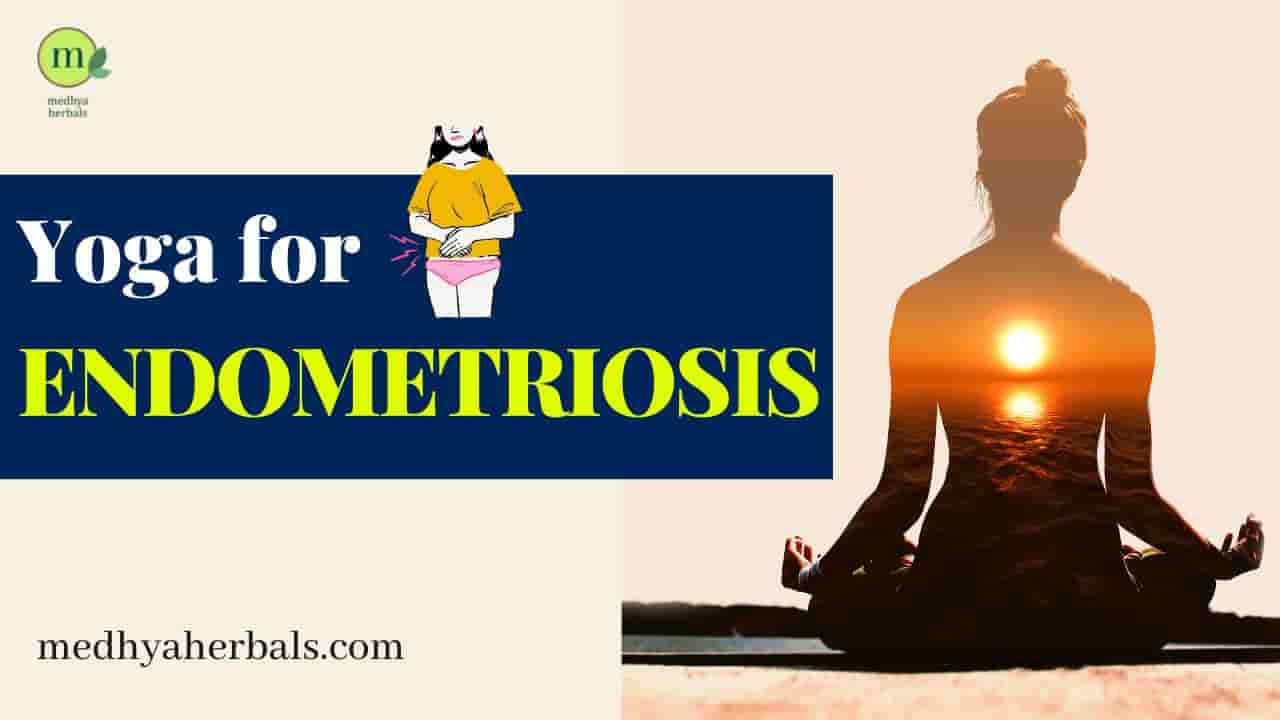Endometriosis can be a painful and frustrating condition to manage, especially when it comes to fertility and hormonal balance. As an Ayurvedic Doctor, I understand how important it is to find natural solutions for endometriosis, and that’s why I want to introduce you to the power of yoga.
Yoga is a gentle and effective way to relieve pelvic pain, balance hormones, and boost fertility, all while supporting your overall health and well-being. In this article, I’ll share the best yoga poses for endometriosis, explain why yoga is better than other exercises like pilates, and show you how yoga can help shrink endometriosis naturally.
So, whether you’re experiencing painful symptoms of endometriosis or just looking to support your reproductive health, read on to discover the many benefits of yoga for endometriosis.
How Does Yoga for Endometriosis Help?
Yoga is a holistic practice that has been shown to help manage a variety of health conditions, including endometriosis pain. The practice of yoga combines physical poses, breathing exercises, and meditation to help balance the body and mind. Here are some ways in which yoga can help manage endometriosis:
- Reducing inflammation: Many yoga poses are designed to gently stretch and strengthen the body. This can help improve circulation, reduce inflammation, and relieve pain.
- Balancing hormones: Yoga is known to help balance hormones by reducing stress and anxiety. This can be especially helpful for women with endometriosis, as the condition is thought to be linked to hormonal imbalances.
- Improving pelvic floor health: Some yoga poses can help strengthen the pelvic floor muscles, which can help alleviate endometriosis pain. Poses such as pigeon pose, lizard pose, and goddess pose are all known to be beneficial for the pelvic floor.
- Reducing stress and anxiety: Endometriosis pain can be incredibly stressful and anxiety-inducing. Yoga can help reduce these feelings by calming the mind and reducing stress hormones.
- Boosting fertility: Yoga can improve reproductive health and increase the chances of conception by reducing stress and balancing hormones.
- Increasing mindfulness: Mindfulness is the practice of being fully present and aware in the moment. Yoga can help increase mindfulness, which can be helpful in managing endometriosis pain by allowing you to fully tune into your body and recognize when you need to rest or take it easy.
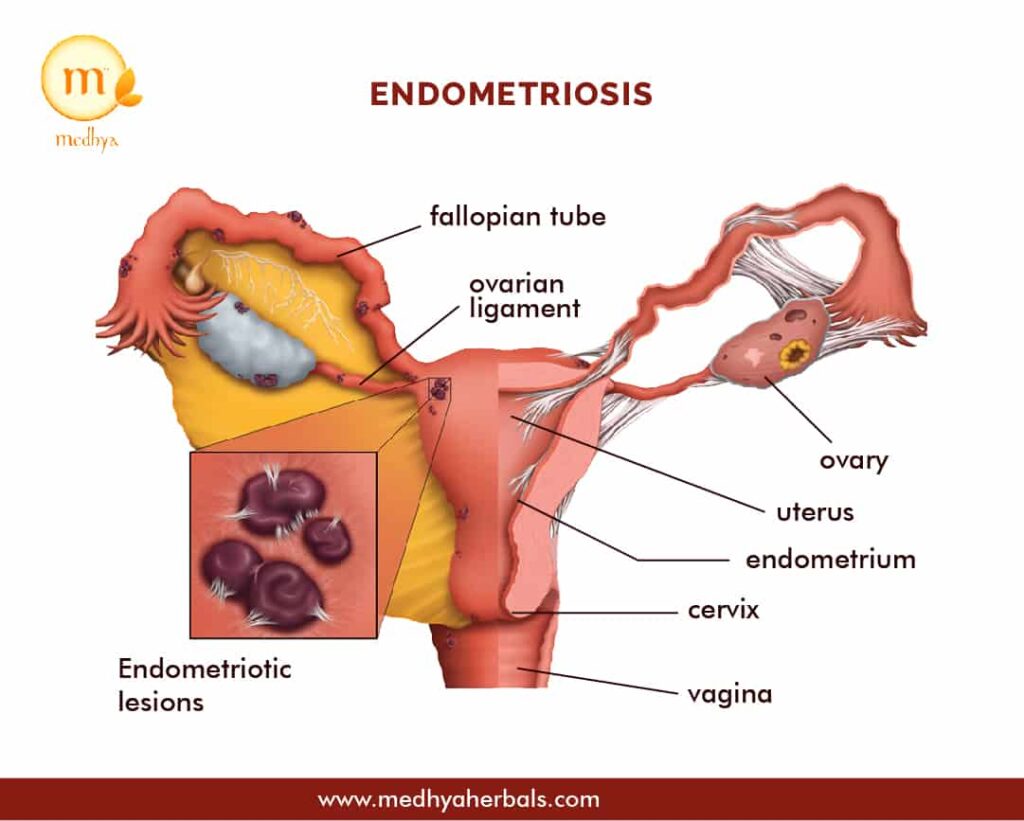
Caution with Yoga for Endometriosis
It’s important to note that while yoga is highly helpful for endometriosis, it’s important to listen to your body and only do what feels comfortable and safe for you.
In addition, it is always a good idea to consult with an experienced practitioner, who can guide you on specific poses that will help your health symptoms. They can help you design a personalised yoga sequence and determine which poses are safe for you and which ones you should avoid.
The Best Yoga Poses for Endometriosis
Now that you know the benefits of yoga for endometriosis, let’s dive into the best yoga poses to relieve pelvic pain, balance hormones, and boost fertility:
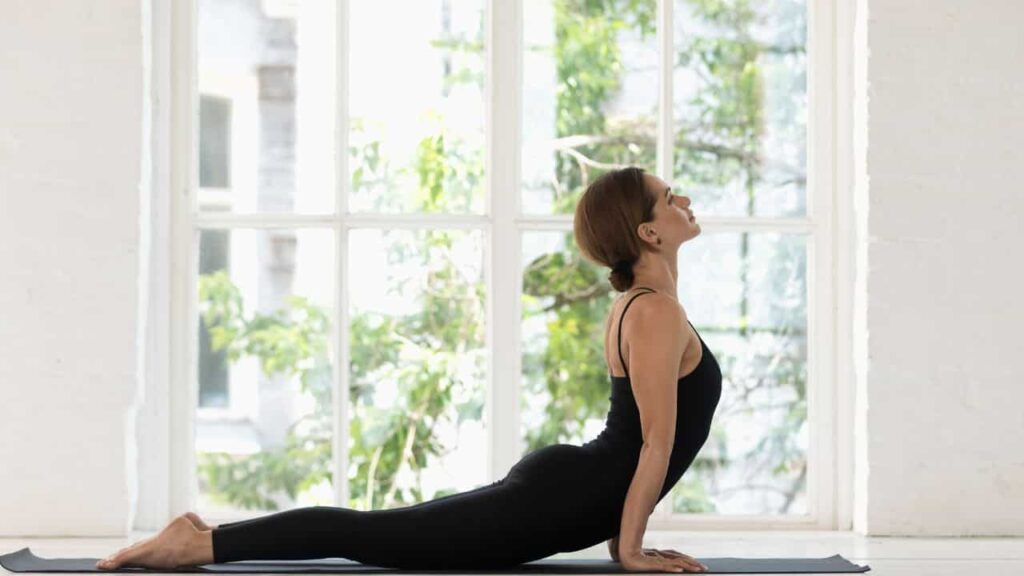
1. Cobra Pose (Bhujangasana)
Cobra pose is an excellent pose for stretching and strengthening the muscles in the lower back and abdomen. It can help relieve menstrual cramps and pelvic pain by increasing blood flow to the reproductive organs. To perform cobra pose, follow these steps:
- Lie flat on your stomach with your hands placed on either side of your chest, palms facing down.
- Slowly lift your head and chest off the floor, using your arms to support your weight.
- Keep your elbows close to your sides, and breathe deeply as you hold the pose for 30 seconds to 1 minute.
- Lower yourself back down to the floor and repeat the pose 2-3 times.

2. Pigeon Pose (Kapotasana)
Pigeon pose is a restorative pose that can help stretch the hips, thighs, and back. It is an excellent pose for relieving tension and pain in the pelvic area. To perform pigeon pose, follow these steps:
- Start on all fours with your hands and knees on the floor.
- Bring your right knee forward and place it behind your right hand. Keep your right foot close to your left hip.
- Slide your left leg back, keeping your hips square to the floor.
- Lower your upper body onto your forearms and breathe deeply as you hold the pose for 1-2 minutes.
- Repeat the pose on the other side.
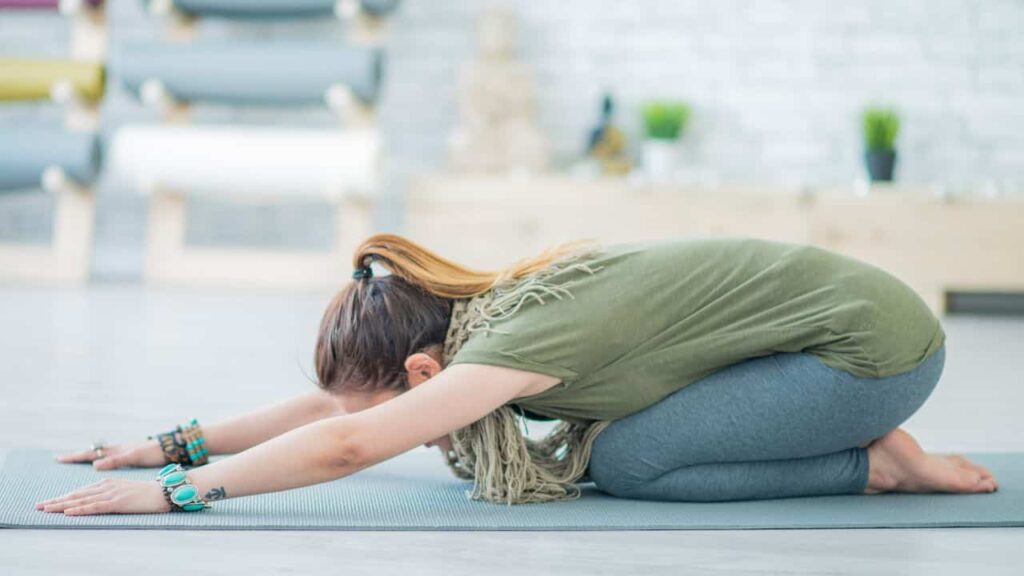
3. Child’s Pose (Balasana)
Child’s pose is a relaxing pose that can help relieve stress and tension in the body. It can also help stretch the hips and lower back, which can be especially beneficial for women with endometriosis. To perform child’s pose, follow these steps:
- Kneel on the floor with your knees hip-width apart and your toes touching.
- Lower your upper body down onto your thighs and stretch your arms out in front of you.
- Rest your forehead on the floor and breathe deeply as you hold the pose for 1-2 minutes.

4. Reclining Bound Angle Pose (Supta Baddha Konasana)
- Start by lying down on your back with your knees bent and feet flat on the ground.
- Bring the soles of your feet together and allow your knees to fall out to the sides.
- Place your hands on your belly or stretch them out to the sides with your palms facing up.
- Close your eyes and breathe deeply, holding the pose for 1 to 5 minutes.
- Release by gently bringing your knees back together and straightening out your legs.
This pose helps to increase blood flow to the pelvic area, reduce inflammation, and alleviate menstrual cramps. It also helps to calm the mind and reduce stress, which can have a positive impact on hormonal balance
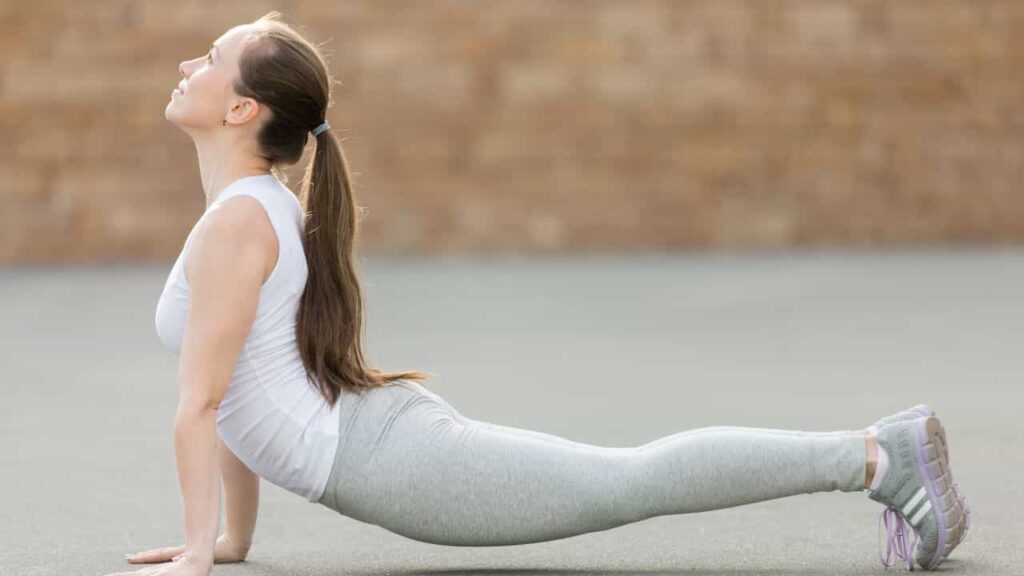
5. Upward-Facing Dog Pose (Urdhva Mukha Svanasana)
- Start by lying down on your stomach with your palms facing down near your ribs.
- As you inhale, straighten your arms and lift your chest and upper body off the mat.
- Keep your thighs and knees off the ground and look up towards the sky.
- Hold the pose for 10 to 15 seconds while breathing normally.
- Release by lowering your body back down to the mat.
This pose helps to relieve menstrual cramps and lower back pain by stretching the abdominal muscles and opening up the chest. It also stimulates the reproductive organs and can help to balance hormones.
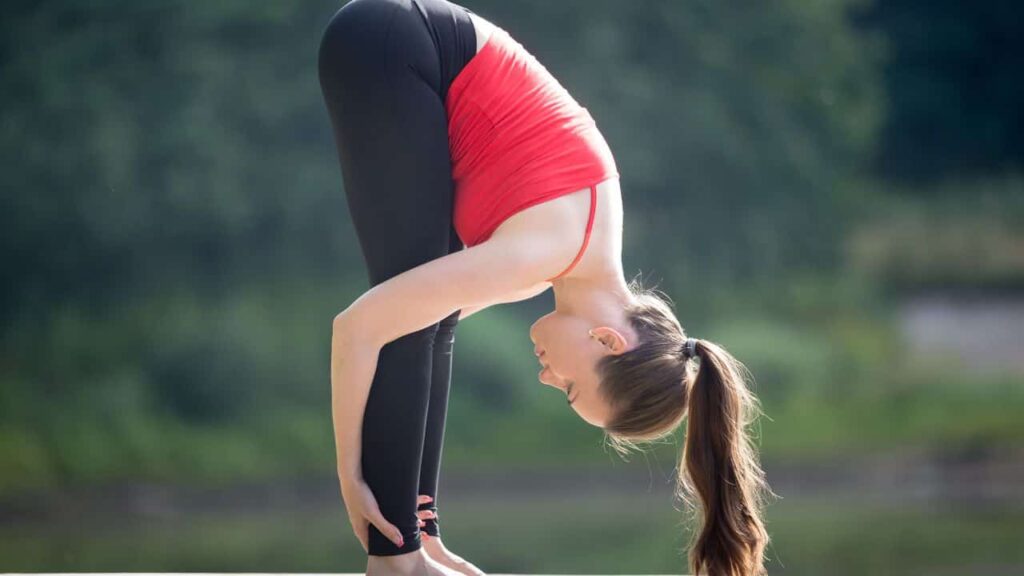
6. Standing Forward Fold Pose (Uttanasana)
- Stand up straight with your feet hip-width apart and your arms by your sides.
- As you exhale, hinge forward at the hips and fold your upper body down towards the ground.
- Allow your head and neck to relax and let your arms dangle down towards the floor.
- Hold the pose for 30 seconds to 1 minute while breathing deeply.
- Release by slowly rolling up one vertebra at a time, returning to a standing position.
This pose helps to stretch the hamstrings and lower back, which can reduce pelvic pain and discomfort. It also helps to calm the mind and reduce stress, which can have a positive impact on hormonal balance.
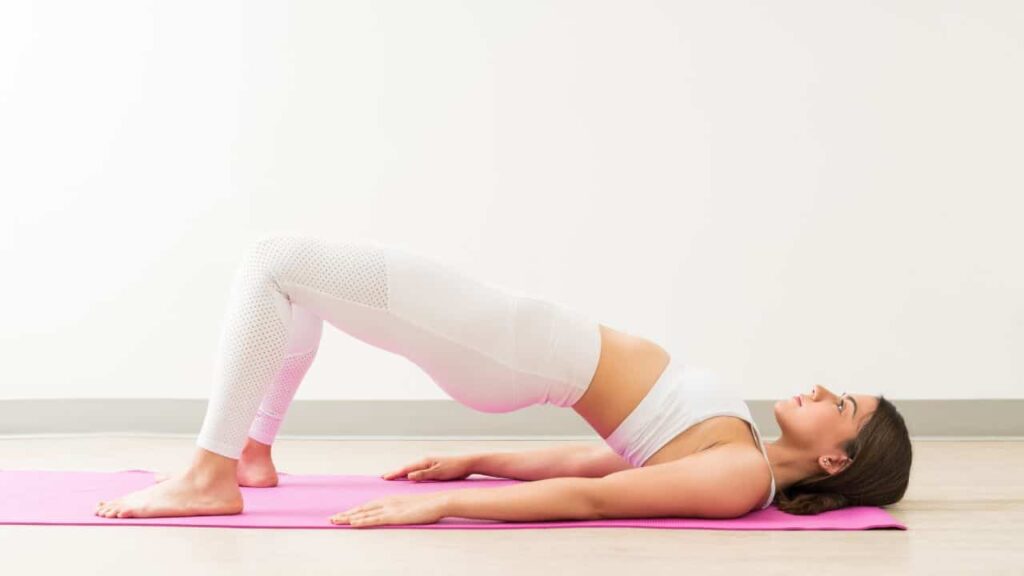
7. Bridge Pose (Setu Bandhasana)
Bridge pose is a gentle backbend that can help stretch the lower back and improve circulation to the pelvic area. It can also help alleviate menstrual cramps and pelvic pain. To perform bridge pose, follow these steps:
- Lie on your back with your knees bent and your feet flat on the floor.
- Place your arms at your sides with your palms facing down.
- Slowly lift your hips up toward the ceiling, using your arms and legs to support your weight.
- Hold the pose for 30 seconds to 1 minute before lowering yourself back down to the floor.
Tips to Incorporate Yoga into a Daily Routine for Maximum Benefits
Incorporating yoga into your daily routine can have a significant impact on your physical and mental well-being. If you have endometriosis, incorporating yoga can be particularly beneficial. Here are some tips on how to incorporate yoga into your daily routine for maximum benefits:
- Set a specific time for yoga: It’s important to set a specific time for yoga each day so that it becomes a habit. Whether it’s in the morning or evening, find a time that works best for you and stick to it.
- Start with short sessions: If you’re new to yoga, start with shorter sessions and gradually work your way up to longer sessions. Begin with 10-15 minutes a day and gradually increase the time as your body gets used to the practice.
- Find a comfortable space: Find a comfortable space in your home where you can practice yoga without any distractions. Make sure the space is well-ventilated and has enough room for you to move around freely.
- Use props: If you have endometriosis, you may find certain poses uncomfortable. Using props like blocks and straps can help you modify the poses and make them more comfortable.
- Listen to your body: It’s important to listen to your body and not push yourself beyond your limits. If a pose feels uncomfortable, modify it or skip it altogether. Remember, yoga is about self-care and not competition.
- Incorporate breathing exercises: Breathing exercises, also known as pranayama, can be particularly helpful for endometriosis. Incorporate breathing exercises like the three-part breath and alternate nostril breathing into your yoga practice for maximum benefits.
Conclusion
Endometriosis can be a challenging condition to manage, but incorporating yoga into your daily routine can be a powerful tool for managing the pain and other symptoms associated with this condition. The yoga poses we discussed can help with fertility, pelvic pain, and hormonal balance, while also promoting relaxation and reducing stress.
At Medhya Herbals, our team of Ayurvedic doctors understands the unique challenges of living with endometriosis, and we are here to help. Our personalized approach to treatment is designed to address the root cause of your pain and provide long-term relief. We invite you to schedule a consultation with our team of Ayurvedic doctors to discuss your specific symptoms and develop a personalized treatment plan that can help you find relief from endometriosis pain.
We understand how difficult it can be to find effective relief from endometriosis, but we want you to know that Ayurvedic root cause treatment can provide permanent relief. We are committed to helping you achieve optimal health and well-being, and we look forward to partnering with you on your journey towards healing.
Don’t let endometriosis pain hold you back any longer. Contact Medhya Herbals today to schedule a consultation with our Ayurvedic doctors and take the first step towards lasting relief.
References
- “The Effect of Yoga on Women with Endometriosis: A Systematic Review and Meta-Analysis.” https://www.ncbi.nlm.nih.gov/pmc/articles/PMC7319158/
- “Endometriosis and Yoga Therapy: An Integrative Approach.” https://www.ncbi.nlm.nih.gov/pmc/articles/PMC6013733/
- “Impact of Yoga on Endometrial Thickness in Infertile Women.” https://www.ncbi.nlm.nih.gov/pmc/articles/PMC4086480/
- “Yoga as Therapy in the Management of Endometriosis: A Systematic Review and Meta-analysis.” https://pubmed.ncbi.nlm.nih.gov/28415067/
- “Effects of Yoga on Symptoms, Quality of Life, and Mindfulness in Women with Endometriosis: A Systematic Review.” https://www.ncbi.nlm.nih.gov/pmc/articles/PMC7036232/

